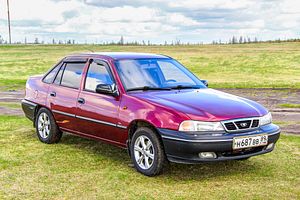Uzbekistan tightly controls its currency, in the past year allowing it to depreciate very gradually. Officially, the Uzbek som has avoided the rapid and massive depreciation experienced by the Kazakh tenge, for example. But, unofficially, as Olim Abdullayev wrote for bne Intellinews this week, it’s a whole different story. On the Uzbek black market the som sits at 6,200 sum to the dollar after tumbling from around 3,200 in early 2015. Official exchange rates have only dropped a fraction of that, from 2,422.4 to the dollar in early 2015 to 2,841.6 as of February 9.
The black market was pulled into the light this week as news broke that Kahramon Oripov, until recently the chairman of Asaka Bank, had been detained for “currency crimes” and “legalization of criminal revenue.” As Joanna Lillis explains for Eurasianet, Oripov’s alleged crime was based on the “unorthodox system through which payments are made to purchase cars in Uzbekistan.” Some cars assembled by GM Uzbekistan can be paid for in dollars, rather than the som:
The money to buy a car must be deposited in dollars at an account in Asaka Bank, which is supposed to transfer it in hard currency to Uzavtosanoat, the state company that holds Tashkent’s share in GM Uzbekistan.
Herein lay Oripov’s profit. He allegedly transferred funds according to the official exchange rates and pocketed the difference between that and the black market rate. The source of the Oripov story is a website (Uzmetronom) both Lillis and Abdullayev note is believed to be linked to the Uzbek security services–which adds another layer of questions (Lillis goes further into the implications of Uzmetronom’s perhaps targeted reporting on this case).
Given the tight market all around, especially for dollars, it’s likely domestic car sales are down. But one thing is certain: foreign car sales are definitely down. While the imploding hydrocarbon market has pulled down the economies of Russia and Kazakhstan, Uzbekistan has felt that drag in other ways. Uzbekistan is a country that depends as much (if not more) on cotton and cars as oil–the former two together account for over 20 percent of Uzbek exports while gas accounts for less than 20 percent. In 2013, Russia accounted for a full 80 percent of Uzbek car exports. But that percentage has been on a downward slant. Trend reported this week that car sales to Russia by GM Uzbekistan continue to drop. It’s a somewhat regular report, too. In October 2015, Trend noted that according to the Automobile Manufacturers Committee of the European Business Association GM Uzbekistan’s sales for the first nine months of 2015 were down over 50 percent compared to that same period in the previous year.
GM Uzbekistan is a joint venture between General Motors (25 percent) and Uzavtoprom (75 percent). It was originally a venture between Uzbekistan and Daewoo, known as UzDaewooAuto, launched in 1996. In 2005 Uzbekistan bought out Daewoo and in 2007 signed an agreement with GM. The cars manufactured in Uzbekistan are sold under several Daewoo and Chevron brand names.

































